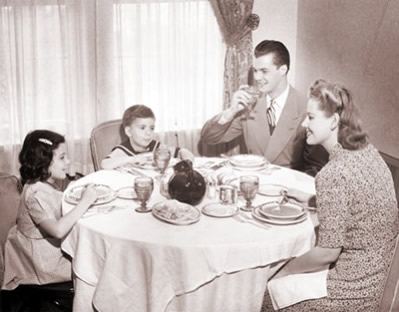Nuclear Family

Americans, particularly in the post WWII period tended to understand society in terms of nuclear families consisting of heterosexual married parents and their biological offspring.
However, even in the US, nuclear families have been the exception rather than the rule.
Next: Extended families
It's no coincidence that the family in the picture appears white, middle-class and wasp-y. It was precisely this kind of family that was declared ideal, and normative by sociologists, psychologists, and politicians. Non-white, immigrant, and poor families were less likely to conform to this model for both cultural and economic reasons. Their families were often pathologized. Social ills from poverty, to delinquency, and crime were blamed, in part, on the large, non-normative families of those who were not middle and upper class whites This, of course, deflected attention from the racism, inequality of opportunity, and lack of adequate educational or employment opportunities members of these families faced.
In class I discuss the Orphan Train movement of 1853-1929. More than a quarter million children were taken from the street and very often from their families, and given to families across America. You can find additional documentation on the Orphan Train movement in many places. These include: The VCE Library's Social Welfare History Project, The Chicago Tribune, the National Orphan Train Complex in Kansas and Several places on PBS.
Really optional stuff: The Orphan Train movement has an interesting connection to anthropology. Its founder, and the founder of the Children's Aid Society (the organization that ran the trains) was Charles Loring Brace (1826-1890). Brace was the son of a prosperous and well connected New England family. He trained at Harvard, Yale Divinity School, and the Union Theological Seminary. He was both a Congregationalist minister and a journalist. Brace was deeply affected by Darwin's On the Origin of Species (which he claimed to have read 13 times). In Brace's interpretation, there was a divine purpose to evolution. Evolution, he believed, offered hope for the perfection of human society by "preserving and adding up all that is good." Brace was convinced that children possessed an innate moral sense but were led astray by bad environmental conditions, particularly poverty (and, arguably Catholicism). Brace's embrace of Darwin led to his study of race and language and in 1863, he published The Races of the Old World. By modern standards, the book is both impressive and disturbing. Brace was an ardent abolitionist and a believer in both human equality and monogenesis (the idea that all humans had the same origin... in Brace's day most "scientists" did not believe this). He found ample evidence for his position. He wrote "There is nothing... to prove the negro radically different from other families of man or even mentally inferior to them" (remember this is 1863 we're talking about here...his position was considerably in advance of almost all white Americans, including anthropologists like Lewis Henry Morgan, who believed only in eventual, not current day equality). However, Brace was deeply disturbed by evidence that showed that languages, cultures, and races were not permanent but could easily change. He wanted to believe that races were equal but unchanging and permanent since that would allow him to argue for black equality but against race mixing. He deeply feared that one day America might not be a white nation. Of course, Brace's idea of evolution always moving toward "the good" or "the best" is not how either Darwin understood or any modern student of evolution understands natural selection. In 1872, Brace traveled to Europe. He stopped in England and met with Darwin. They had an extensive and pleasant discussion, but Darwin said to Brace: "Yes, it is very unpleasant of these facts; they won't fit in as they ought to!" (All this based on Fuller 2017: "Reading Charles Darwin Utterly Changed How Charles Loring Brace Thought about Social Reform"). Anyhow, Brace's son, Charles Loring Brace Jr. was trained as a civil engineer but, after his father's death, became the head of the Children's Aid Society. His son, Gerald Warner Brace was a novelist, English professor, and famously, a boat builder and sailor. His son, C. Loring Brace (1930-2019), was a well known biological anthropologist and paleoanthropologist. C. Loring Brace, following in his great grandfather's footsteps, also wrote about race. However C. Loring Brace's 2005 Race is a Four Letter Word: The Genesis of a Concept traced the history of the idea of race and demonstrated that race has no biological validity. So, C. Loring Brace demonstrated and accepted what his great-grandfather's work suggested but what his great grandfather was not willing to accept.
